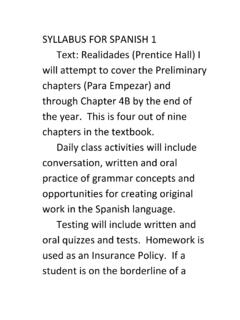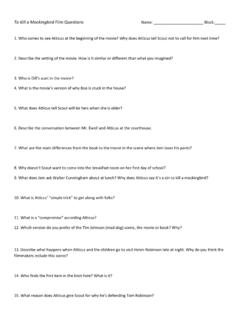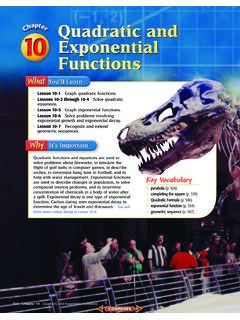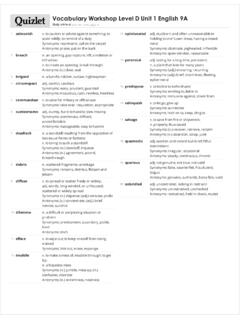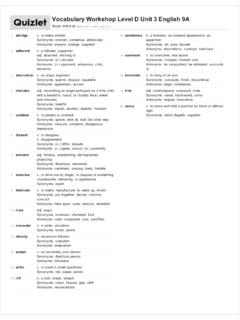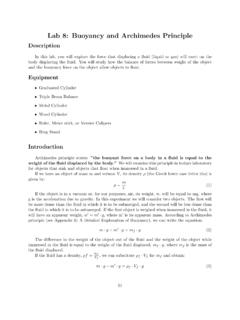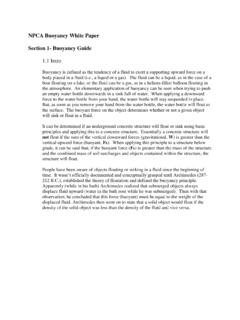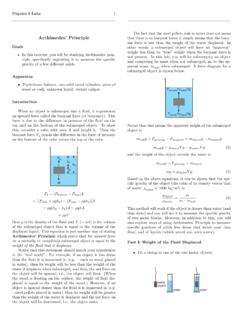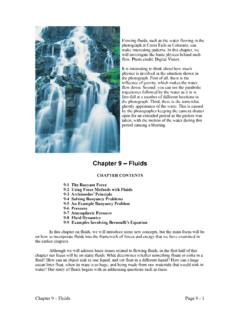Transcription of Liquids & Buoyant Force
1 Liquids & Buoyant Force Notes (p275 HRW) Liquids Study of Liquids Hydrostatics Liquids that are stationary archimedes , Pascal Hydrodynamics Liquids that are moving Bernouilli Fundamental Characteristic Density ( ) How is density defined? mass/volume = m/V What are density units in SI kg/m3 (standard) or gm/cc (common) Example water = 1000 kg/m3 (or 1 gm/cc) gold = x water lead = x iron = x ice = x balsa = x air = kg/m3 Lower density floats on higher density Pressure (p) Definition: Force perpendicular to plane/area over which Force is acting P = Force /Area = F/A SI Units = pascals (Newtons/meter2) Air Pressure Standard air pressure @ sea level and 20 C, expressed as.
2 X 105 Pa 1 atmosphere 760 mm (or 76 cm) of mercury 30 inches of mercury Measured by a barometer or manometer Average tire pressure ~ 200 kPa or 30 psi (lbs/in2) Hydrostatic (Gauge) Pressure Fluid pressure increases with depth because the water at a depth must support the weight of water above it. Ex. Diving to the bottom of the deep end of a pool what do you feel? Air pressure P = gh, where = density of fluid g = m/sec2 h = depth of fluid (ex. height of water column) This is gauge pressure Container shape?
3 NO EFFECT! Absolute/Total Pressure Add atmospheric pressure (Pair) which acts on the surface of the fluid and the total pressure becomes Ptotal = Pair + gh Generically The pressure at the bottom of a column (Pb) equals the pressure at the top (Pt) PLUS the pressure due to the column, or Pb = Pt + gh Practice - submarines A sub dives to a depth of 200 m. How much water pressure must the hull be able to withstand, or what is the (gauge) water pressure at 200 m? Solve P = gh P = 1000 x x 200 P = x 106 Pa Every sq meter of surface must withstand ~ 2 million newtons Note: in this example we have NOT included the air pressure pushing on the top of the water!
4 Submarines Maximum depth classified, but generally believed to be ~1500 ft for US and ~2500 ft for Russian Sub disasters Thresher ( 63), sank off Cape Cod in 8400 ft after joint to outer hull failed, flooding sub Kursk (2000), Barents Sea, 350 ft after torpedo accident Practice How deep (h) must a diver go before he experiences another atmosphere ( x 105 Pa) of water pressure? Solve for h in water ( = 1000 kg/m3) P = gh x 105 = 1000 x x h h = m (~34 feet) Roughly, every 30 feet of dive adds 1 atmosphere of pressure to a diver Interesting facts on diving!
5 Deepest free dive 124 m (~400 ft) feet Deepest assisted dive 214 m (~700 ft) Breath holding record >19 minutes Mini-lab Density determination of 3 samples Measure Write-up Submit Pascal s Principle Pressure applied to an enclosed fluid is transmitted equally and undiminished to every part of the fluid, as well as the walls of the container. P1 = P2, (Pressure a point 1 = pressure at point 2) 2211 AFAF Application of Pascal s Principle Hydraulic lift service stations Examples of Pascal s Principle Examples Example The small piston of a hydraulic lift has an area of m2.
6 If a car weighing N sits on the large piston, area m2, how large a Force must be applied to the small piston to support the car? F1/A1 = F2/A2 F1 = F1 = * = N What is buoyancy ? In physics, buoyancy is the upward Force acting on an object in a fluid, and can be: Positive Neutral Negative Alligators & crocodiles? What causes buoyancy ? buoyancy is the result of the difference in pressure exerted on the top and bottom of an object. Question If you place a rock into a bucket of water, say filled, what will you observe about the water line in the bucket?
7 It will rise to reflect the volume of the rock if the rock was m3, the water would rise m3, b/c the rock is submerged. This is an example of archimedes archimedes Principle - example In air the stone weighs 44 N In water the stone weighs 36 N Buoyant Force is the difference = 8N buoyancy Example Weight in air Apparent weight Fb = Weight in air weight in water buoyancy - archimedes archimedes Principle When a body is partly or wholly submerged in a fluid, it will experience a Buoyant Force (Fb)equal to the weight of the fluid displaced.
8 Buoyant (Upthrust) Force (Fb) Fb = Weightfluid displaced = (massfluid)*(g) Fb = ( fluid)*(Vfluid displaced)*(g) (Note: =m/V or m= *V) Fb = ( V)*g directed upward! Case 1 object is submerged Fb = ( fluid)*(Vfluid displaced)*(g) Case 2 object is partially submerged (floating) Fb = ( object)*(Vobject)*(g) buoyancy Summary Table IF THEN object > fluid Wobj > Fb sinking object = fluid Wobj = Fb neither sink nor float object < fluid Wobj < Fb float = density, W = weight Fb = Buoyant Force Example of archimedes Principle & Buoyant Force If a house brick of density ( ) 2000 kg/m3 and volume (V)
9 Of m3 is placed in a bucket of water, what is the Buoyant Force (Fb) acting on a brick? Solve: Fb = Vg Fb = 1000 x x Fb = N Buoyant Force Practice An ice cube is floating in a glass of water ( =1000 kg/m3). The ice, whose density is 917 kg/m3, has dimensions of x x m. What is the Buoyant Force on the ice? Solve: Note: the ice is floating thus the Buoyant Force = weight of the ice Fb = ( V)*g (use , V for ice, not water) Fb = 917*( * * )* Fb = N Buoyant Force Practice A ferry boat is 4 m wide and 6 m long.
10 When a truck pulls onto it, the boat sinks 4 cm in the water. What is the weight of the truck? Use archimedes Principle: Weight of truck = weight of water displaced (find this displacement) Weight = mass x g Mass of water (m) = density x volume m= 1000 x (4 x 6 x ) = 960 kg Weight = m x g = 960 x = 9,408N Buoyant Force Practice Example A piece of metal weighs in air and when completely immersed in water. What is the Buoyant Force ? Fb = = What is the density ( ) of the object? Fb = Vg ( , V refer to the fluid when submerged) V = Fb / g = (1000* ) = m3 Mass = = kg = m/V = = 8000 kg/m3 buoyancy - icebergs If an object is floating on the surface, then the volume that is below the surface can be determined as follows: Vf/Vo = o/ f, where Vf= volume of object that is below surface Vo= volume of the object o = density of the object f = density of the fluid % Iceberg in salt water that is below surface =.

